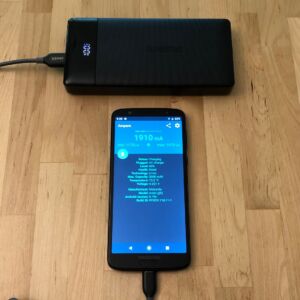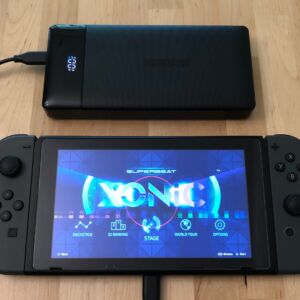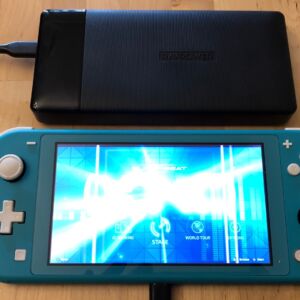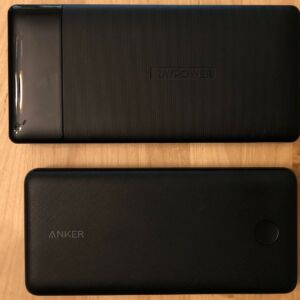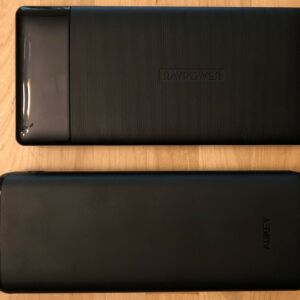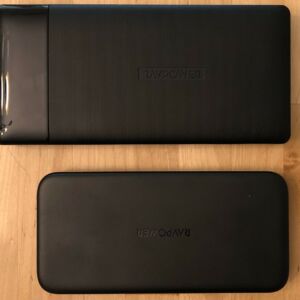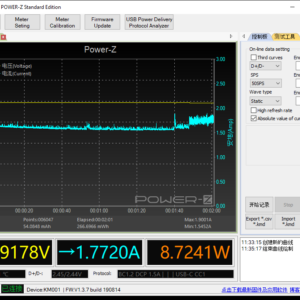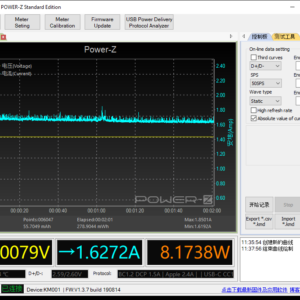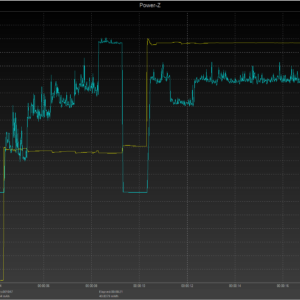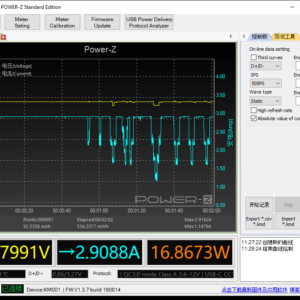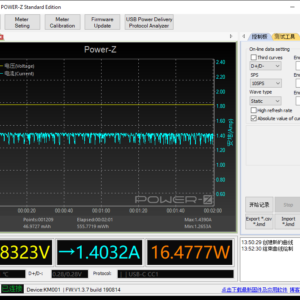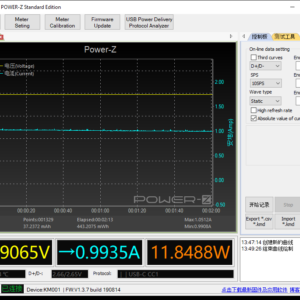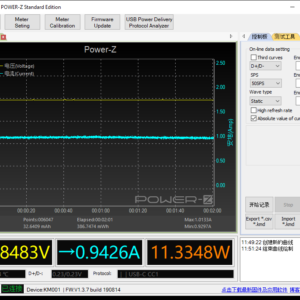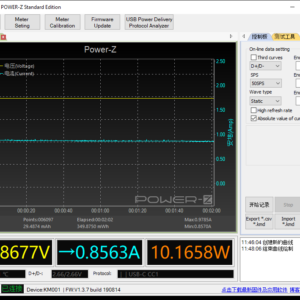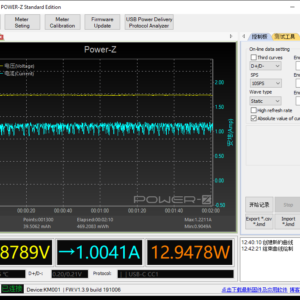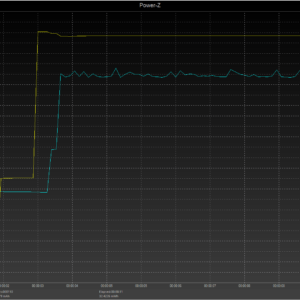RAVPower PD Pioneer 20000 18W - Large capacity power bank aimed at phones and small devices
Summary
The RAVPower PD Pioneer 20000 18W supports 18W USB-C PD and Quick Charge. Ideal for most phones, small tablets, and the line of Nintendo Switches. With twice the capacity of a pocket sized model. And several input and output options.
Overall
-
Performance
(4.5)
-
Design
(5)
-
Safety
(4)
-
Recharge Time
(4.5)
User Review
( votes)Pros
- Fast charges iPhone, Samsung Galaxy, Google Pixel, LG, and Motorola phones
- Charges Switch while you play
- Fits in most Switch carrying cases, but takes up most of the accessory pocket
- LCD shows a more exact capacity level (0-100%)
- Recharge the power bank with USB-C, micro-USB, or Lightning
- Supports pass through charging
- Charge two devices at once
- Within FAA limits for lithium batteries and flights
Cons
- Disables fast charging when two or more devices are connected
- Quick Charge 3.0 over USB-C is against USB-C specs
- Can’t be recharged by Nintendo Switch AC Adapter
- Doesn’t include a USB-C to USB-C cable
Disclosure: As an Amazon Associate I earn from qualifying purchases. I purchased the product in this review.
No products found.
Model: RP-PB172
Tech Specs:
- Ports: USB-C, USB-A x2, micro-USB, Lightning
- USB-C Output:
- 18W USB-C Power Delivery 3.0 (5V/2A, 9V/2A, 12V/1.5A)
- Quick Charge 3.0
- Apple 2.4A
- USB-A Output (Quick Charge port):
- 18W Quick Charge 3.0
- Apple 2.4A
- USB-A Output:
- 12W USB (5V/2.4A)
- Apple 2.4A
- Input: 18W USB-C PD (5V/2A, 9V/2A, 12V/1.5A)
- Capacity: 20,000mAh | 74Wh
- Size: 6.2 x 2.9 x 0.6 inches | 157.5 x 73.7 x 15.2 mm
- Weight: 15.7 oz | 445 grams
Included In Box:
- RAVPower PD Pioneer 20000 18W
- micro-USB cable
Good For:
- Commute
- Travel
- iPhone
- Android
- Nintendo Switch (handheld)
- iPad Pro
Estimated Number of Charges:
- iPhone 6/7/8/SE: 7 charges
- iPhone Plus/X/XR: 4 charges
- iPhone 11, Samsung Galaxy S8/S9: 4 charges
- Samsung Galaxy S10: 4 charges
- Nintendo Switch (2017): 9.75 hours of play
- Nintendo Switch (2019): 15 hours of play
- Nintendo Switch Lite: 14.5 hours of play
First Impression
The RAVPower PD Pioneer 20000 18W is a typical, rectangular form factor of a 20,000mAh power bank. Its stand-out feature is an LCD in place of the more typical LEDs for displaying the remaining capacity. With a 4 LED system, you know within 25% how much power you have left. With an LCD you get a 0-100% number, taking a lot of the guesswork out. Though the estimate itself is still only an estimate. And tends to drop faster below 50%. When charging the LCD blinks and displays the current charge level.
All five ports at on the front panel. Which I prefer over a port hiding on the side. They are in a logical order. The micro-USB and Lightning ports (used for input only) are on the left. The USB-C port (output and input) is next. Followed by the two USB-A ports. The green one next to the USB-C supports Quick Charge.
The enclosure around the LCD invites smudges. But most of it is matte black plastic. Good luck trying to read the technical specifications. With are in an even darker black on a black background.
Compared To Similar Power Banks
| Charger | RAVPower PD Pioneer 20000 18W 3-Port | Anker PowerCore Essential 20000 PD | AUKEY PB-Y14 20000 USB-C PD | AUKEY PB-Y23 20000 Universal |
| Ports | USB-C, USB-A x2 | USB-C, USB-A | USB-C, USB-A x3 | USB-C, USB-A |
| Output | 18W USB-C PD Quick Charge 3.0 | 18W USB-C PD PowerIQ 2.0 (QC compatible) | 18W USB-C PD Quick Charge 3.0 | 18W USB-C PD Quick Charge 3.0 |
| Capacity | 20,000mAh | 20,000mAh | 20,000mAh | 20,000mAh |
| Features | LCD shows capacity with 0-100% | |||
| Cable | No cable | USB-C to USB-C cable | No cable | USB-C to USB-A cable |
| Dimensions | 6.2 x 2.9 x 0.6 in 15.7 oz | 6.2 x 2.9 x 0.8 in 12.1 oz | 7.8 x 3.8 x 0.6 in 15.3 oz | 7 x 2.7 x 1 in 14.6 oz |
| Price | No products found. | $61.99 | No products found. | No products found. |
Prices are from Amazon Product Advertising API, last updated on 2024-10-22.
You can see more USB-C power banks here.
Device Testing
Check with your device’s manufacturer to verify which charging standards it supports.
USB Power Delivery & Quick Charge 4+ Phones
- Apple iPhone 8/X/XR/XS/11/SE
- Essential Phone
- Google Pixel
- LG ThinQ/V30
- Razer
- Samsung Galaxy S8/S9/S10
- Samsung Galaxy Note 8/9
- Xiaomi Mi 8/9
- ZTE Axon Pro 9/10
Using an iPhone 8 for testing we find USB PD phones will fast charge over the USB-C port. iPhones will need to use a USB-C to Lightning cable, not included. And Android phones will need a USB-C to USB-C cable, also not included.
For iPhones, the USB-A port supports Apple 2.4A. An older, but still functional fast-charging standard. Older iPhones (4-7) can fast charge using either USB-A port. Newer iPhones will charge ~15 minutes faster using USB-C.
Quick Charge 3.0 Phones
- HTC
- LG
- Motorola
- Nokia
- Samsung Galaxy
- Sony
- Xiaomi Mi 5/6
- ZTE
Using a Moto G6 for testing we see Quick Charge will fast charge over the green USB-A port. Any QC supporting Android phone with USB-C can use the included USB-C to USB-A cable.
Nintendo Switch
The Nintendo Switch charges at the expected rate with a 12V charger. The original model will draw up to 12W, shy of its 18W max draw. This is due to a shortcoming with the Switch itself. But it is more than enough to charge while you play. The new model Switch (2019) and Switch Lite don’t have this issue. And will draw at or near their max draw rate.
Learn more about charging the Switch.
Slower Recharge, But Not That Slow
Like its output specs, the RAVPower PD Pioneer 20000 18W can only input up to 18W via the USB-C port. Its micro-USB port can also support up to 18W, provided you use a Quick Charge charger. Its Lightning port only gets up to 10.5W. But will be less than 5W if you use Apple’s iPhone USB power adapter.
That’s not a lot of input for a power bank twice the size of most other 18W models. With USB-C I was able to recharge the power bank 0-100% in ~5,5 hours. A Quick Charge should be able the same. While Lightning will be twice as long.
Given the 20,000mAh and output for smaller devices, you shouldn’t zero out this power bank often. And giving it a partial recharge will be faster. But should you drain it then expect it to take half a day or overnight to recharge.
No Fast Charging With Two or More Devices
If you connect two or more devices to the power bank it will disable all fast charging tech. When you connect the second device you’ll notice the charging resets on the first. This is the power bank stepping down to a 5V output level. If you disconnect the second device you’ll want to unplug and replug the first. To make sure fast charging turns back on.
This limitation is typical of most power banks. The few I’ve seen which allow for two fast-charging devices are unusually large. There is a limit to how much current can cross its circuits without extra hardware. Which adds size, weight, and cost.
Most smaller devices will revert to their normal charging rate. Which will continue to charge the battery while they are in use. The total charge time for the two devices is about the same. Whether you fast charge them one at a time. Or charged them at a slower rate together.
Quick Charge 3.0 Over USB-C
The presence of Quick Charge over USB-C is against USB-C specifications. Such chargers have been around for years without issue. But we don’t know what the future holds.
Under section 4.8.2 of USB-C specifications, a proprietary charging method cannot change the voltage of USB-C output (between 4.40V and 5.25V) in a manner not defined by USB methods. Quick Charge operates at higher than default voltages. And so goes against the specifications. USB Power Delivery is an open-source charging method. Created alongside USB-C, it is with specs even though it also increases the voltage. The big difference is USB PD uses communication lines to negotiate power transfer. While proprietary methods take over the data lines for their negotiation. They do so because legacy USB connections, such as USB-A, don’t have comm lines.
There is no known risk with running proprietary charging standards over USB-C. Manipulating the data lines does disrupt data transfers. But when plugging into a wall charger or power bank there is no data transfer anyway. Some USB-C engineers warn against using any USB-C chargers with third party standards. Their concern is unforeseen consequences. Future technology may prove to be incompatible with such configurations. And pulling out a charger several years from now with a new device could have a bad result.
I have not run into any issues with these fast charging standards on this or any other charger. But as it is a spec violation I want you to be informed. If you’re a stickler for meeting USB-C specifications this isn’t a good charger for you. If you’re more pragmatic it works fine and has no known issues.
Pass-Through Charging
Pass-through charging allows a portable charger to both charge itself and a connected device. The power received from the wall charger splits. Some to the portable charger’s own batteries. And some to the connected device. How it handles the split varies. And there are more inefficiencies than normal.
This portable charger supports pass-through charging under these connections:
- Input: USB-C, Output: USB-A (6.5W)
- Input: micro-USB, Output: USB-C (5W)
- Input: Lightning, Output: USB-C (5W)
- Input: Lightning, Output USB-A (5.1-5.6W)
Pass-through charging is useful when you only have one USB wall charger. But it is not recommended to use this feature regularly. It puts more heat and stress on the portable charger. Which will affect its lifespan. It can also provide an inefficient charge to your device. Again, not great for its own battery’s lifespan.
If you like to have the option when traveling, fine. But don’t set this up next to your bed at home every night.
Summary
The RAVPower PD Pioneer 20000 18W is a good, large capacity power bank. Made for iPhone, most Androids, Nintendo Switch, and other small devices. It is more capacity than your phone needs for a day trip. And not enough output for a laptop. It works best for multi-day charging. Whether at a convention, outdoors, or want to reduce the number of times you need to charge your power bank.
For phones the USB-C port fast charges iPhone 8/X/XR/XS/11, Samsung Galaxy, and Google Pixel. And the green USB-A port will fast charge most Samsung, LG, and Motorola models. And any other Android which supports Quick Charge.
It’ll charge any model Nintendo Switch while you play. The original mode underdraws power. While the updated model and Lite draw closer to their max rate.
If you need to fast charge a device it needs to be the only one connected. Connecting a second device will disable fast charging across the board. Otherwise, you can normally charge two devices at once. Or three devices, though they’ll charge a bit slower still.
Pass-through charging is available. But with quite low outputs, between 5-6.5W depending on the setup. That’s okay for overnight charging. But it shouldn’t need to be a regular thing with so much capacity and smaller devices.
The LCD is a nice feature. Giving the power bank a distinct look. And allowing you to see how much power remains. Without having to round to the nearest 25%.
About RAVPower
RAVPower has U.S. based support (web, email, phone) and an 18-month warranty. The warranty can be extended to 30 months if you register the product with RAVPower. They are a respected brand within the USB-C community.
Bottom Line
The RAVPower PD Pioneer 20000 18W’s output best supports phones, tablets, and the Switch. Its capacity will keep those devices running for a long time. Use it as a recharge once a week commute charger. Or for long trips with infrequent charging points.
Buy if you:
- Only need to charge phones, tablets, and similar size devices on the go
- Need enough capacity for a few days, or want to reduce the number of times the power bank gets recharged
- Want to see an actual number instead of a few dots when checking capacity
Don’t buy if you:
- Need to also charge a USB-C laptop
- Want a pocket-sized power bank
- Prefer to travel light, and won’t have an issue finding wall outlets
No products found.
You’ll want a USB-C wall charger to quickly recharge this USB-C power bank. I recommend the RAVPower Super-C 18W 2-Port. It’ll support the same type of devices, as well as the power bank.
Be sure to check the Deals page to see if this or a similar charger is on sale.
Enjoyed this review? Sign up for the Switch Chargers newsletter and get updates on future reviews and Nintendo Switch related deals.




